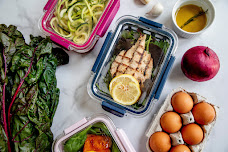When it comes to eating healthy, there are countless benefits that come along with it. For one, you’re likely to have more energy and feel better overall when you make healthy food choices. Additionally, eating right can help reduce your risk of developing chronic conditions like heart disease, diabetes, and certain types of cancer.
Of course, eating healthy doesn’t just mean consuming more fruits and vegetables (although that’s definitely part of it). It also means making smart choices when it comes to the other foods you eat and being mindful of portion sizes.
The bottom line is that there are plenty of good reasons to make healthy eating a priority in your life. By taking some time to learn about nutrition and incorporating healthier foods into your diet, you can enjoy all the benefits that come with eating well.
Healthy eating has countless benefits that extend far beyond weight loss. Proper nutrition is linked with reduced risk of heart disease, arthritis, diabetes, high blood pressure, and some forms of cancer. Eating a healthy diet can also lower your cholesterol and help keep your blood sugar in check. In addition to these health benefits, eating a nutritious diet can also give you more energy and improve your mood.
One of the best ways to make sure you are getting all the nutrients your body needs is to eat a variety of healthy foods from all the food groups. The United States Department of Agriculture’s (USDA) dietary guidelines recommend filling half your plate with fruits and vegetables, making at least half your grains whole grains, choosing lean protein sources, and dairy mostly in the form of fat-free or low-fat milk and yogurt. Limiting solid fats (like butter, shortening, and lard), added sugars, and sodium will also help create a healthier eating pattern.
To help you create a healthy meal, the USDA’s ChooseMyPlate website provides information on how to build a healthy plate as well as tips on what foods to choose from each food group. You can also use their SuperTracker tool to track how many calories you are eating in a day and see where your diet may need improvement. Creating a healthy eating pattern is not about being perfect but rather about making small changes over time that fit into your lifestyle.
Tips for a Healthy Breakfast
A healthy breakfast is one of the most important meals of the day. It jump-starts your metabolism, provides essential nutrients and energy, and sets the stage for a healthy day.
Here are some tips for a healthy breakfast:
1. Include protein: Protein helps keep you satisfied and fuels your body throughout the day. Good sources of protein include eggs, Greek yogurt, nuts and seeds, nut butter, cottage cheese, and smoked salmon.
2. Add fruits or vegetables: Fruits and vegetables are packed with vitamins, minerals, antioxidants, and fiber. Add them to your breakfast for an extra nutritional boost.
3. Go for whole grains: Whole grain breads, cereals, and oats are rich in fiber and other nutrients that help regulate blood sugar levels and keep you feeling full longer.
4. Avoid sugary cereals: Cereals that are high in sugar can cause spikes in blood sugar levels that leave you feeling tired and hungry later on. Choose cereals that are lower in sugar or make your own granola with healthy ingredients like nuts, seeds, and dried fruit.
5. Make it easy to eat healthy breakfast foods: If you find it hard to eat a nutritious breakfast every morning, make ahead some healthy options like overnight oats or chia pudding that you can grab and go. You can also prep ingredients like fruits and vegetables so they’re ready to add to a smoothie or eggs dish.
Tips for a Healthy Lunch
When it comes to packing a healthy lunch, there are a few things you should keep in mind. First, aim for a balance of healthy carbohydrates, proteins, and fats. This will help to keep you feeling full and satisfied throughout the day. Second, make sure to include plenty of fruits and vegetables. These provide essential vitamins and minerals as well as fiber which is important for digestion. Finally, don’t forget to pack some healthy snacks! This will help you avoid temptation when those mid-day cravings hit.
Some easy and healthy lunch ideas include:
-A salad with grilled chicken or fish, mixed greens, tomatoes, cucumbers, and light dressing
-A whole grain wrap with turkey or salmon, avocado, and leafy greens
-A bowl of veggie soup with a side of fruit
-A yogurt parfait with granola and berries
With these tips in mind, packing a healthy lunch is easy and delicious!
Tips for a Healthy Dinner
When it comes to making a healthy dinner, there are a few key things to keep in mind. First, focus on incorporating plenty of fresh fruits and vegetables into your meal. Not only are they packed with nutrients, but they can also help to fill you up so you don’t overeat. Second, make sure to include a source of lean protein such as chicken or fish. And third, choose healthy carbohydrates such as whole grain rice or quinoa instead of processed white flour products. By following these simple tips, you can easily create a delicious and nutritious meal that will leave you feeling satisfied and energized.

.jpg)
.jpg)
.jpg)
.png)
0 Comments